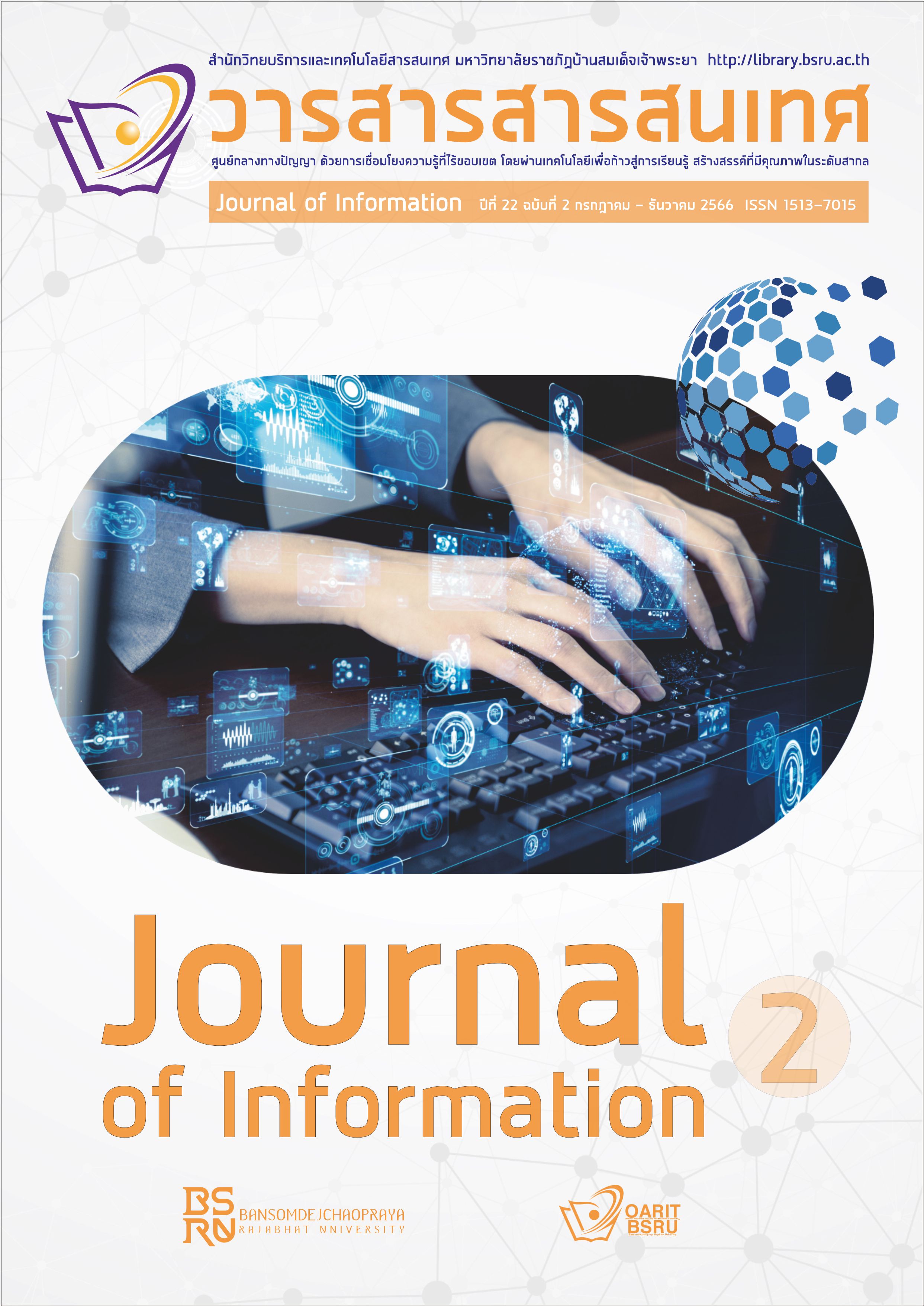Ontology Development for Library Science Taxonomy Based on Facet Categorization
Keywords:
Ontology, Taxonomy, Library Science, Facet CategorizationAbstract
The purposes of this study were to 1) develop an ontology of library science terminology by facet classification and 2) to evaluate an ontology of library science terminology. Data were collected from search terms in library database by selecting 320 library science related words. The ontology was developed by content analysis to define knowledge structures and group terms using facet classification. The knowledge was divided into 12 domains as follows: 1) intellectual property 2) library and information science career 3) information sources 4) knowledge management 5) information resources 6) social media 7) classification 8) archives 9) library’s tasks 10) librarian professional associations 11) search tools and 12) digital libraries. The ontology consisted of 44 main classes, 243 subclasses, 4 types of 13 hierarchical relationships, and 39 instances. The ontology was evaluated using a Delphi technique by 9 experts to validate the classification and structure of the ontology, including the completeness and relationships within the structure. It was found that, on average, the completeness was at the highest level ( =4.78), the consistency was at the highest level (
=4.78), the conciseness was at a high level (
=4.44), the accuracy was at the highest level (
=4.85) and the clarity was at the highest level (
=4.78).
References
กรพินธุ์ ทวีตาม, จุฑาทิพย์ อังศุสิงห์, สาลินี ชุ่มวรรณ์, บุศยารัตน์ คู่เทียม, ลัดดา ชูชาติ, ศุภราพร ฤกษ์ดิกุล,
กมลชนก ชวนะเกรียงไกร, สาคร พิพวนนอกและ วรนุช วีณะสนธิ. (2559). คู่มือวิชาการพื้นฐานการบริหารและจัดการงานจดหมายเหตุ (พิมพ์ครั้งที่ 2 ฉบับปรับปรุง).
สำนักหอจดหมายเหตุแห่งชาติ กรมศิลปากร.
กุสลวัฒน์ คงประดิษฐ์. (2560). หลักการในการดำเนินงานหอจดหมายเหตุ. ภาควิชาสารสนเทศศึกษา คณะมนุษยศาสตร์และสังคมศาสตร์ มหาวิทยาลัยบูรพา.
ชนิศา บุญวงษ์ (2558). การพัฒนาระบบการจัดการฐานความรู้ด้วยออนโทโลยี กรณีศึกษา บัณฑิตวิทยาลัย มหาวิทยาลัยศิลปากร. [วิทยานิพนธ์ศิลปศาสตรมหาบัณฑิต, มหาวิทยาลัยศิลปากร].
พัฑรา พนมมิตร. (2560). การพัฒนาออนโทโลยีความรู้ด้านผ้าล้านนา. [วิทยานิพนธ์ศิลปศาสตรมหาบัณฑิต,มหาวิทยาลัยเชียงใหม่].
มหาวิทยาลัยสุโขทัยธรรมาธิราช. สำนักบรรณสารสนเทศ และสำนักงานพัฒนาวิทยาศาสตร์และเทคโนโลยีแห่งชาติ. ฝ่ายบริการความรู้ทางวิทยาศาสตร์และเทคโนโลยี. (2561). หลักและแนวปฏิบัติการจัดการจดหมายเหตุดิจิทัล. สำนักบรรณสารสนเทศ มหาวิทยาลัยสุโขทัยธรรมาธิราช.
ราชวิทย์ ทิพย์เสนา. (2561). การพัฒนาฐานความรู้ออนโทโลยีสำหรับภาชนะดินเผาแหล่งโบราณคดีบ้านเชียงจังหวัดอุดรธานี. ว.วิจัยสมาคมห้องสมุดแห่งประเทศไทยฯ. 11(1), 16-32.
โรจน์ศักดิ์ เกิดทรัพย์. (2554). การประยุกต์ใช้ออนโทโลยีสำหรับการสืบค้นสารสนเทศของพรรณไม้มีพิษในประเทศไทย. [วิทยานิพนธ์วิทยาศาสตร์มหาบัณฑิต, มหาวิทยาลัยเทคโนโลยีพระจอมเกล้าพระนครเหนือ].
โรสริน อัคนิจ, ธนิต พุทธพงษ์ศิริพร, น้ำฝน ลำดับวงศ์ และ อารีย์ ธัญกิจจานุกิจ. (2554). การพัฒนาออนโทโลยี เพื่อการจัดการความรู้ด้านการแปรรูปข้าว. ว.เกษตร. 27(3), 267-274.
ล้วน สายยศ และอังคณา สายยศ. (2538). เทคนิคการวิจัยทางการศึกษา (พิมพ์ครั้งที่ 4). สุวีริยาสาส์.
วรรษพร อารยะพันธ์ และพัฑรา พนมมิตร. (2562). การพัฒนาออนโทโลยีความรู้ด้านผ้าล้านนา. มนุษยศาสตร์สาร. 20(2), 133-170.
วิไล อิ่มอุระ. (2548). การพัฒนาฐานความรู้การแก้ปัญหาอุปกรณ์คอมพิวเตอร์เบื้องต้นด้วยตนเอง โดยวิธีออนโทโลยี กรณีศึกษา สำนักงานสถิติแห่งชาติ [สถาบันเทคโนโลยีพระจอมเกล้าพระนครเหนือ]. กรุงเทพมหานคร.
สำนักหอจดหมายเหตุแห่งชาติ. (2559). คู่มือวิชาการพื้นฐานการบริหารและจัดการงานจดหมายเหตุ (พิมพ์ครั้งที่ 2 ฉบับปรับปรุง). สำนักหอจดหมายเหตุแห่งชาติ กรมศิลปากร.
อภิฤดี จันทะเดช และมาลี กาบมาลา. (2561). การพัฒนาออนโทโลยีนิทานพื้นบ้านอีสานเพื่อการสืบค้นและเข้าถึง. ว.ศรีนครินทรวิโรฒวิจัยและพัฒนา สาขามนุษยศาสตร์และสังคมศาสตร์. 10(20), 191-206.
Browne, G., & Jermey, J. (2004). Website Indexing: enhancing access to information with in websites. Website Indexing.
Gruber, T. R. (1995). Toward principles for the design of ontologies used for knowledge sharing? International journal of human-computer studies. 43(5-6), 907-928.
Hedden, H. (2016). The accidental taxonomist (2nd ed.). Information Today, Inc.
Lange, A., & Atkinson, C. (2019). On the Rules for Inheritance in LML. In 2019 ACM/IEEE 22 nd International Conference on Model Driven Engineering Languages and Systems Companion (MODELS-C) (pp. 113.118). IEEE.
Luchev, D., Paneva-Marinova, D., & Rangochev, K. (2008). Use of knowledge technologies for presentation of bulgarian folklore heritage semantics. Information Technologies and Knowledge. 2, 307-313.
Mommers, L. (2010). Ontologies in the legal domain. In Theory and Applications of Ontology: Philosophical Perspectives (pp. 265-276). Springer.
Noy, N. F., & McGuinness, D. L. (2001). Ontology Development 101: A Guide to Creating Your First Ontology. Knowledge Systems Laboratory. 32.
Pieterse, V., & Kourie, D. G. (2014). Lists, taxonomies, lattices, thesauri and ontologies: paving a pathway through a terminological jungle. Ko Knowledge Organization. 41(3), 217-229.
Prieto-Díaz, R. (2003). A faceted approach to building ontologies. Proceedings Fifth IEEE Workshop on Mobile Computing Systems and Applications (pp. 458-465). IEEE.
Rashidi, Z. (2015). Properties of Relationships Among Objects in Object-Oriented Software Design. International Journal of Programming Languages and Applications. 5(4), 1-13.
Rout, R. (2018). Enhancement of subject searching in OPAC using ontology. Revista ESPACIOS. 39(44).
Sawsaa, A. (2013). A generic model of ontology to visualize information science domain (ois). [Doctor of Philosophy Dissertation, University of Huddersfield].
Sirithumgul, P. (2016). An Ontology-based Algorithm as a Foundation of an Automated Knowledge Assessment Tool Applied in the Scientific Discussions. [Doctor of Philosophy Dissertation, The Claremont Graduate University].
Slavic, A., & Davies, S. (2017). Facet analysis in UDC: questions of structure, functionality and data formality. KO KNOWLEDGE ORGANIZATION. 44(6), 425-435.
Xu, F., & Ma, L. (2021). Exploring the research themes and their relationships of LIS in China from 2013 to 2018 using co-word analysis. The Journal of Academic Librarianship. 47(1), 1-9.
Zins, C. (2007). Knowledge map of information science. Journal of the American society for Information Science and Technology. 58(4), 526-535.
Downloads
Published
How to Cite
Issue
Section
License

This work is licensed under a Creative Commons Attribution-NonCommercial-NoDerivatives 4.0 International License.
บทความ ข้อความ ภาพประกอบ และตารางประกอบที่ลงพิมพ์ในวารสารเป็นความคิดเห็นส่วนตัวของผู้นิพนธ์ กองบรรณาธิการไม่จำเป็นต้องเห็นตามเสมอไป และไม่มีส่วนรับผิดชอบใดๆ ถือเป็นความรับผิดชอบของผู้นิพนธ์เพียงผู้เดียว






